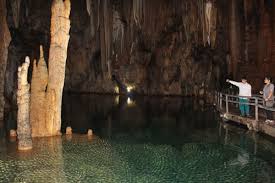
(HBO) - We visited Nam Son cave, Nam Son commune (Tan Lac) on the last days of July. We were quite surprised when we moved through a cave of about 1m high and we saw a wide open space in the cave. There are blocks of virtual fossils. The air in the cave is cool and the holy sound of water is like a light wordless song.
More than ten years ago, some local people accidentally lost
their way into the heart of the cave and the saw a really beauty there. Since
then, many people have come there to explore. Nam Son cave is also called Ton
cave by the local people. The cave is located at an altitude of nearly 1,000
meters above the sea level. It has a length of 455m, a depth of 49m with a
large lake surface, from 2 to 7m deep, and the water is transparent throughout
the year. In addition to owning a treasure of stone columns, stalactites,
stalagmites and stone curtains, it has also preserved many artifacts relating
to history, culture and beliefs and is habitat of many bats, the animals and
the endemic creatures.
The scientists have recognized Nam Son as the most beautiful
and attractive cave in the population of caves discovered in Ngoc Son - Ngo
Luong Nature Reserve with the blocks of stone developed over the course of
about 250 million years. Nam Son Cave
was recognized as a national landscape relic in 2008.
Currently, the authorities of Nam Son commune have conducted
the propaganda to raise the awareness of protecting the landscape of tourism
resources. The province and district have also planned and invested in some
items such as steps up and down, the lighting system, training to guide
tourists to visit the cave area.
On July 25th, Tan Lac district organized the
opening ceremony of the community tourism spot in the Nam Son commune.
Accordingly, they will implement the propaganda solution and they will train
the skills to make tourism to exploit the tourism potential of Nam Son in
association with preserving the unique cultural values of Muong ethnic people.
Besides connecting the tours, the routes, building the private tourism products
of the highlands such as Nam Son ancient tangerine, the purple garlic, chayote
and other products from the local people. Since then, developing tourism will
contribute to the sustainable poverty reduction.
A diverse chain of eco-tourism and resort destinations concentrated in Hoa Binh city and the districts of Tan Lac, Da Bac, and Luong Son… Along with the launch of several key high-quality resort tourism projects, these developments have reshaped the landscape and enhanced the appeal of Hoa Binh as a travel destination.
Boasting diverse terrain, a mild climate, and rich natural resources, Cao Phong district is increasingly asserting its place on Vietnam’s tourism map, attracting both domestic and foreign visitors. The district is renowned for its stunning landscapes, majestic mountains, a crystal-clear hydropower lake, and the unique cultural identity of local ethnic groups.
With its pristine landscapes, unique cultural heritage of Muong ethnic minority, and an expanding range of visitor experiences, Tan Lac district of Hoa Binh has fast become a captivating destination for both domestic and international tourists.
Until now, Sung village in Cao Son commune, Da Bac district remains the only Dao ethnic community in Hoa Binh province to develop a community-based tourism model. Beyond its untouched natural landscapes, cultural identity serves as the cornerstone attraction for visitors.
Alongside the diverse cultural identities of the Kinh, Muong, Tay, Thai, Dao, and Mong ethnic people, Hoa Binh province is also renowned as the "capital" of the northwestern Vietnamese cuisine, offering unique and distinctive dishes. At festivals, during Lunar New Year (Tet), or on significant family or community occasions, special dishes are prepared, leaving a lasting impression on visitors.
A Phong Linh (Yellow Tabebuia) flower garden in Thang village, Thach Yen commune, Cao Phong district is currently in full bloom, drawing a large number of visitors.


